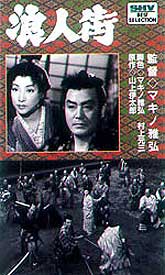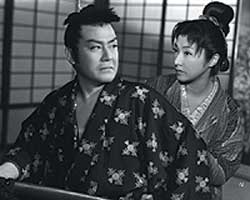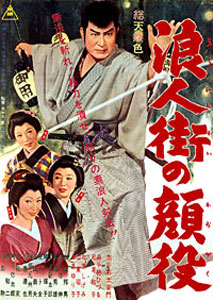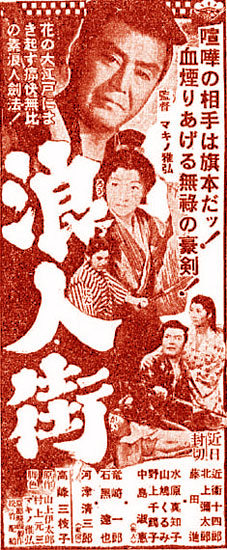A classic pulp novel of the 1920s was Ronin-gai or Street of Masterless Samurai by Itaro Yamagami. It looked at the tragic, comic, & violent lives of fallen samurai who lived at the end of a ghetto street on the outskirts of Edo.
It was first filmed in 1928 as a multi-story silent epic directed by Masahiro Makino, who was the son of Japanese film pioneer Shozo Makino. It extended to 56 reels & has been considered by film historians to stand among the earliest & most imporant "left-leaning" or "tendency films" in Japan, critical of the feudal system rather than over-romanticizing samurai.
 The dreams & ambitions of the impoverished ronin far exceeded their chances of opportunity, & they dwelt among the lowest of denizens, witness to common peoples' victimization by castle samurai. The dreams & ambitions of the impoverished ronin far exceeded their chances of opportunity, & they dwelt among the lowest of denizens, witness to common peoples' victimization by castle samurai.
Part One of the silent film epic starring Komei Minami was Ronin-gai: Dai-ichiwa utsukushiki emono (Samurai Town: Beautiful Prey, Showa Toji, 1928). It was a popular film & received the Kinema Jumpo Award in 1928, but was perceived as a fable criticizing the military of the time, so was heavily censored. It is now mostly lost, though fragments of the ending survive.
Part Two Ronin-gai dainiwa gakuyaburo kaiketsuhen (Samurai Town II: Bath in the Dressing Room, Showa Toji, 1929) has six reels that survive more or less intact, preserved at the Matsuda Film Library in Tokyo.
Part Three Ronin-gai daisanwa tsukareta hitobito (Samurai Town III: The Obsessed, 1929) does not survive.
Makino remade the film himself. His first remake was Ronin-gai (Nikkatsu Tokyo, 1939) starring Ryunosuke Tsukigata & Ryosuke Kagawa. The second remake was Yoidore Hachiman-ki (A Horde of Drunken Knights, 1951) starring Ryunosuke Tsukigata, Kensaku Hara, Chikako Miyagi, Seizaburo Kawazu.
 His third remake was Ronin-gai (1957) starring Jushiro Konoe, Susumu Fujita, Seizaburo Kawazu, Ichiro Ryuzaki, & Mieko Takamine. The video box & a still are shown here for this 1957 version. His third remake was Ronin-gai (1957) starring Jushiro Konoe, Susumu Fujita, Seizaburo Kawazu, Ichiro Ryuzaki, & Mieko Takamine. The video box & a still are shown here for this 1957 version.
The Elegant Swordsman (Furyu katsujinken, 1934) was strongly influenced by Roningai, from the director Sadao Yamanaka whose refusal to make films that glorified rather than criticized the warrior spirit got him shipped off to Manchuria by an annoyed military government, & he die at the front.
The Elegant Swordsman alas is lost as are most of Yamanaka's films, but we know it depicted life in a poor boarding house, revealing the dreams of common people, rather than glorifying daimyo lords or famous samurai.
Yamanaka's Humanity & Paper Balloons (Ninjo kami fusen, 1937) fortunately does survive & again shows life in a run-down boarding house with a ronin interacting with peasants, struggling, dreaming, & ultimatey failing.
 The first color version was filmed at Toei, & shown in North America as Boss of Samurai Street; & eventually on a subtitled grey market dvd as Brave Ronin (Ronin-gai no kaoyaku, 1963). This latter was a remake of a particularly cheerful revision, directed by Sentari Shirai for Daito Studios in 1936.
The first color version was filmed at Toei, & shown in North America as Boss of Samurai Street; & eventually on a subtitled grey market dvd as Brave Ronin (Ronin-gai no kaoyaku, 1963). This latter was a remake of a particularly cheerful revision, directed by Sentari Shirai for Daito Studios in 1936.
In the naive 1963 version, a samurai of Edo castle decides to live in the ghetto of the city because he is convinced life will be more rewarding there, which right away undermines the original intent of the story to show samurai as miserably down & out.
This ronin-by-choice comes to live in an inn which sort of specializes in housing ronin. The new arrival's constant cheerfulness is grating to other ronin, who at one point betray him for money, then end up helping him out because he so easily forgives them.
Veteran chambara star Utaemon Ichikawa as the central protagonist is an endearing fellow. His chaste relationship with a geisha "wanted" by a bad-guy is heartwarming. In the original story the ronin are involved with the lowest sorts of prostitutes who ply their trade on mats by the riverbank, but Yasushi Sasaki's version was clearly intended to be more child-friendly.
In one scene when young kyokaku (gang members) try to show their muscle & rudeness to the new man in the quarter, Utaemon's character dismisses them with the easy insult "Must be country bumpkins. Townsmen are gentle."
The romantic liberalism of "poor people are nicest" can almost be forgiven if only because the film is such grand fun with exciting though bloodless swordplay. But the story does get syrupy after a while. Once our happy ronin sets everything on the street of unemployed samurai to rights, he heads off to the next impoverished corner of the city to play superhero to others in need, the "happy" ending getting downright insulting of commoners.
As our happy-go-lucky ronin walks through the streets, the devoted, heart-won townsfolk bow to him in abject admiration as he passes among them straight & tall. It's quite a contrast to Daisuke Ito's views of the relations between samurai & commoner, & it would surely have annoyed the story's original creator as well as its first director.
copyright © by Paghat the Ratgirl
|

 The dreams & ambitions of the impoverished ronin far exceeded their chances of opportunity, & they dwelt among the lowest of denizens, witness to common peoples' victimization by castle samurai.
The dreams & ambitions of the impoverished ronin far exceeded their chances of opportunity, & they dwelt among the lowest of denizens, witness to common peoples' victimization by castle samurai. His third remake was Ronin-gai (1957) starring Jushiro Konoe, Susumu Fujita, Seizaburo Kawazu, Ichiro Ryuzaki, & Mieko Takamine. The video box & a still are shown here for this 1957 version.
His third remake was Ronin-gai (1957) starring Jushiro Konoe, Susumu Fujita, Seizaburo Kawazu, Ichiro Ryuzaki, & Mieko Takamine. The video box & a still are shown here for this 1957 version.